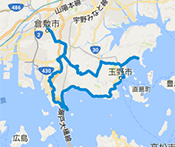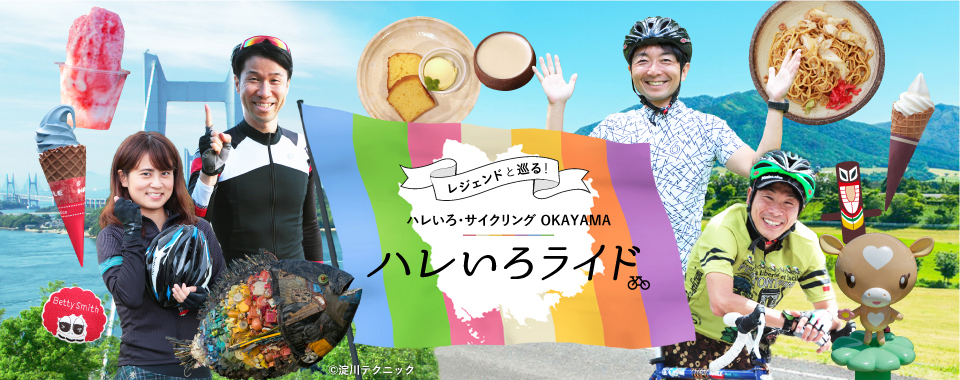KATATETSU ROMAN KAIDOU ROUTE
This route has a nostalgic feel as it runs along the Katatetsu Roman Kaido, created from a disused railway line, and then along the banks of the Yoshii River. There is much to enjoy, including a dip in the waters of Yunogo Onsen, fresh seafood at Hinase, or why not try a plate of local specialty Tsuyama horumon udon noodles in the castle town of Tsuyama?
- Level
- ★★☆Intermediate
- Distance
- 76km
- Highest elevation
- 125m
- Total elevation gain
- 468m
- Average time required
- 2h30m
- Recommended season
- Spring Cherry blossom season
Sample local delicacies along this nostalgic route that covers the Katatetsu Roman Kaido and the Yoshii River.
ROUTE VIEW POINTRoute view point

View of Hinase Bay (Bizen City)
With a total length of 765 m, the Bizen♡Hinase Bridge links Bizen-Hinase Town with Kakuijima Island. From the bridge, you can see a sight unique to Hinase; countless oyster rafts bobbing in the sea.

Hinase Kakioko (Oyster Okonomiyaki) (Bizen City)
This local dish is made only during winter months using oysters caught fresh each day. The fresh oysters are succulent even after being cooked, and add a luxurious taste to this special okonomiyaki.

Bizen Pottery (Bizen City)
Bizen pottery is made without using any glaze and is simply baked at high temperatures. Of the six ancient kilns of Japan, Bizen is the oldest of them all.

Katatetsu Roman Kaido (Wake Town)
This cycling road runs for 34 km and was created using the former Katatetsu railroad tracks. Aspects of the road’s former life are still apparent, as you can see station buildings, platforms, and signals along the way.

Wake Ugaidani Onsen (Wake Town)
With a high sulfur content, this onsen hot spring is famous even beyond Okayama for its healing and beautifying properties including easing neuralgia, and joint and muscle pain as well as improving sensitivity to cold and relieving fatigue.

Yunogo Onsen (Mimasaka City)
The waters of Yunogo have been famed since ancient times for their miraculous healing properties and the town has been adored as a health resort for many years. Among the three springs in Mimasaka City, Yunogo is the only chloride spring, with just a slight saltiness and light sulfurous odor. A free foot spa in the center of town is popular with tourists.

Joto Historical Preservation District (Tsuyama City)
Joto is the eastern entrance to the historic castle town of Tsuyama and faces the former Izumo High Road. It was once the home to the merchants and artisans of the town. The hook-shaped winding streets and the lanes still bearing their ancient names really make the atmosphere feel like an old castle town.

Tsuyama Castle (Kakuzan Park) (Tsuyama City)
The stone walls of the former Tsuyama Castle still stand proud today with a height of approximately 10 m and stones placed intricately together forming a maze-like warren of lanes across a wide area. Even from a distance, it is possible to make out the overlapping layers of these walls. The park is famous as one of western Japan’s most beautiful spots in spring when cherry blossoms bloom, and has earned a spot as one of Japan’s top 100 cherry blossom sites.

Shurakuen Garden (former villa garden of the feudal lord of Tsuyama) (Tsuyama City)
This traditional strolling garden was commissioned by Mori Nagatsugu, the second feudal lord of Tsuyama, who invited a master gardener from Kyoto to add his finishing touches. The garden is said to imitate that of the Sento Imperial Palace in the Kyoto Gyoen National Garden. It was given its current name in 1870 and entrance is free.

Tsuyama Horumon Udon (Tsuyama City)
Tsuyama has long been a place where wagyu cattle have been bred and this is why it has always been possible to source delicious and fresh offal from the local sashu beef cattle. More than 50 restaurants in Tsuyama offer this special dish, with each one differing slightly depending on the chef.
ACCESSAccess to start and finish point(s)
- ●Via car:
- Approx. 10 minutes from Bizen IC on the Okayama Blue Line to Hinase Port, then approx. 25 minutes by ferry
- ●Via train:
- From JR Okayama Station
Approx. 60 minutes to JR Hinase Station, get off at JR Hinase Station, walk approx. 10 minutes to Hinase Port, then approx. 25 minutes by ferry
- ●Via train:
- From JR Tsuyama Station
Approx. 90 minutes to JR Okayama Station
PARKING SPACEParking lots around the start and along the route
Parking
-
- Bizen Municipal Parking Lot▲スタート地点付近
- Hinase, Hinase-cho, Bizen City 701-3204
-
- Bizen City Cycling Terminal
- 1011-3 Nishikatakami, Bizen City 705-0021
-
- Wake Municipal Station Parking Lot
- 572-17 Fukutomi, Wake-cho, Wake-gun 709-0442
- Parking lot: Approx. 40 cars (paid)
-
- Wake Ugaidani Traffic Park
- 681-1 Masubara, Wake-cho, Wake-gun 709-0452
- Parking lot: Approx. 110 cars (free)
-
- Mimasaka City General Athletic Park
- 1200 Nakayama, Mimasaka City 707-0061
HOTELRecommended hotels for cyclists
-
Wake Ugaidani Onsen, hot spring

- Address
- 666-1 Masubara, Wake-cho, Wake-gun 709-0452
- TEL
- 0869-92-9001
- HP
- Hotel Website
-
Chikutei

- Address
- 622-1 Yunogo, Mimasaka City 707-0062
- TEL
- 0868-72-0090
- HP
- Hotel Website
-
The Shiroyama Terrace Tsuyama Villa

- Address
- 30-1 Sange, Tsuyama City 708-0022
- TEL
- 0868-24-2111
- HP
- Hotel Website
-
Nishikien Ryokan

- Address
- 840-1 Yunogo, Mimasaka City 707-0062
- TEL
- 0868-72-0640
- HP
- Hotel Website
-
Kifu no Sato

- Address
- 180 Yunogo, Mimasaka City 707-0062
- TEL
- 0868-72-1523
- HP
- Hotel Website
- KURASHIKI TAMANO
SEASIDE ROUTE - Level of difficulty / ★★☆ Intermediate

- Distance
- 90km
- Highest elevation
- 219m
- BICCHU AROUND
HISTORICAL VISITING ROUTE - Level of difficulty / ★★☆ Intermediate
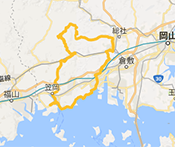
- Distance
- 108km
- Highest elevation
- 409m
- OKUKIBI
YAMABIKO ROUTE - Level of difficulty / ★★★ Advanced
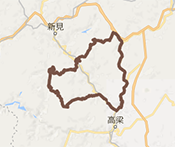
- Distance
- 83km
- Highest elevation
- 451m
- MANIWA SHINJO
YAMANAMI ROUTE - Level of difficulty / ★★☆ Intermediate
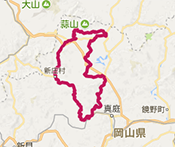
- Distance
- 100km
- Highest elevation
- 539m
- KATATETSU
ROMAN KAIDOU ROUTE - Level of difficulty / ★★☆ Intermediate
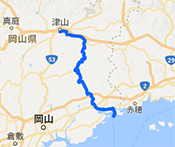
- Distance
- 76km
- Highest elevation
- 125m
- OKAYAMA KAGAMINO
THROUGH ROUTE - Level of difficulty / ★★★ Advanced
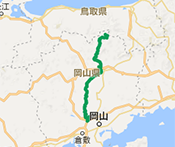
- Distance
- 114km
- Highest elevation
- 791m
- KIBIJI
CYCLING ROUTE - Level of difficulty / ★☆☆ Beginner

- Distance
- 25km
- Highest elevation
- 26m
- HIRUZEN-KOGEN
HEIGHTS CYCLING ROUTE - Level of difficulty / ★☆☆ Beginner
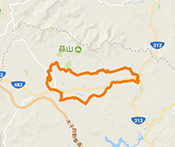
- Distance
- 29km
- Highest elevation
- 135m

KURASHIKI TAMANO
SEASIDE ROUTE
- Level / ★★☆ Intermediate
-
- Distance
- 90km
- Highest elevation
- 219m
BICCHU AROUND
HISTORICAL VISITING ROUTE
- Level / ★★☆ Intermediate
-
- Distance
- 108km
- Highest elevation
- 409m
OKUKIBI
YAMABIKO ROUTE
- Level / ★★★ Advanced
-
- Distance
- 83km
- Highest elevation
- 451m
MANIWA SHINJO
YAMANAMI ROUTE
- Level / ★★☆ Intermediate
-
- Distance
- 100km
- Highest elevation
- 539m
KATATETSU
ROMAN KAIDOU ROUTE
- Level / ★★☆ Intermediate
-
- Distance
- 76km
- Highest elevation
- 125m
OKAYAMA KAGAMINO
THROUGH ROUTE
- Level / ★★★ Advanced
-
- Distance
- 114km
- Highest elevation
- 791m
KIBIJI
CYCLING ROUTE
- Level / ★☆☆ Beginner
-
- Distance
- 25km
- Highest elevation
- 26m
HIRUZEN-KOGEN
HEIGHTS CYCLING ROUTE
- Level / ★☆☆ Beginner
-
- Distance
- 29km
- Highest elevation
- 135m
- ●Tourist-related inquiriesTourism Division, Industry and Labor Department, Okayama Prefecture TEL 086-226-7382
- ●Inquiries about the recommended cycling routesRoad Maintenance Division, Civil Engineering Department, Okayama Prefecture TEL 086-226-7472
©Hareiro Cycling Okayama, All Rights Reserved



